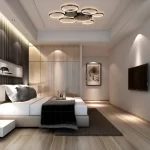Introduction: The Convenience of Remote-Controlled Ceiling Fan Lights
Remote-controlled ceiling fan lights offer a convenient and stylish way to illuminate your living space while simultaneously circulating air for comfort. However, like any electrical device, they can occasionally encounter issues that may disrupt their functionality. In this guide, we’ll explore common troubleshooting tips to help you address issues with your remote control ceiling fan light and get it shining brightly once again.
Understanding the Basics: Components of a Remote Control Ceiling Fan Light
Before delving into troubleshooting, it’s helpful to understand the basic components of a remote-controlled ceiling fan light. These typically include:
- The fan motor: responsible for circulating air.
- The light fixture: provides illumination.
- The remote control: allows for convenient operation of both the fan and light settings.
- The receiver unit: located within the fan housing, receives signals from the remote control and controls the fan and light functions.
Familiarizing yourself with these components can aid in identifying the source of any issues you encounter.
Issue 1: The Light Won’t Turn On
If your ceiling fan light fails to illuminate when commanded, several potential issues may be at play:
- Check the Power Source: Ensure the fan is receiving power by verifying that the circuit breaker or fuse controlling the fan is intact. If the power source is functioning correctly, move on to the next step.
- Inspect the Bulb: Sometimes, a simple solution such as replacing a burnt-out bulb can resolve the issue. Carefully remove the bulb cover and inspect the bulb for signs of damage or malfunction. If necessary, replace the bulb with a new one of the same type and wattage.
- Examine the Remote Control: Ensure the remote control is functioning correctly by checking the batteries. Replace the batteries if they are depleted, as weak batteries can prevent the remote from transmitting signals effectively.
- Reset the Receiver: If the above steps fail to resolve the issue, try resetting the receiver unit. Turn off the power to the fan at the circuit breaker, wait a few minutes, then turn it back on. This may reset the receiver and restore functionality to the light.

Issue 2: The Light Flickers or Flashes
If your ceiling fan light flickers or flashes intermittently, it can be both annoying and concerning. Here’s how to address this issue:
- Check the Bulb Connection: Ensure the bulb is securely screwed into the socket and making proper contact. Loose connections can cause flickering or flashing. Turn off the power to the fan before inspecting and adjusting the bulb to avoid electrical shock.
- Inspect the Wiring: Examine the wiring connections between the light fixture and the receiver unit. Loose or damaged wiring can disrupt the flow of electricity, leading to flickering or flashing. If you’re comfortable working with electrical components, carefully inspect the wiring and tighten any loose connections. Otherwise, consult a qualified electrician for assistance.
- Consider Voltage Fluctuations: Voltage fluctuations in your home’s electrical system can also cause flickering or flashing lights. Installing a voltage stabilizer or surge protector may help regulate the electrical supply to prevent these issues.
Issue 3: The Light Stays On or Won’t Turn Off
If your ceiling fan light remains illuminated despite attempts to turn it off, or if it won’t respond to commands to turn on, the following steps may help resolve the issue:
- Check the Remote Control: Ensure the remote control is functioning correctly by pressing the buttons and observing the indicator light. If the indicator light doesn’t illuminate or responds intermittently, replace the batteries and try again.
- Reset the Remote Control: Sometimes, resetting the remote control can resolve communication issues between the remote and the receiver unit. Refer to the manufacturer’s instructions for steps on resetting the remote control to its default settings.
- Inspect the Receiver Unit: If the issue persists, there may be a problem with the receiver unit located within the fan housing. Inspect the receiver for signs of damage or malfunction, such as loose wiring or burnt components. If you suspect a faulty receiver, contact the manufacturer for guidance on troubleshooting or replacement.
Conclusion: Enjoying the Benefits of a Well-Functioning Ceiling Fan Light
A remote-controlled ceiling fan light can enhance the comfort and ambiance of any room, but encountering issues with its functionality can be frustrating. By following the troubleshooting tips outlined in this guide, you can identify and address common issues with your ceiling fan light, restoring it to optimal performance. Remember to prioritize safety when working with electrical components, and don’t hesitate to seek professional assistance if needed. With a little troubleshooting know-how, you can continue to enjoy the convenience and illumination provided by your remote control ceiling fan light for years to come.


